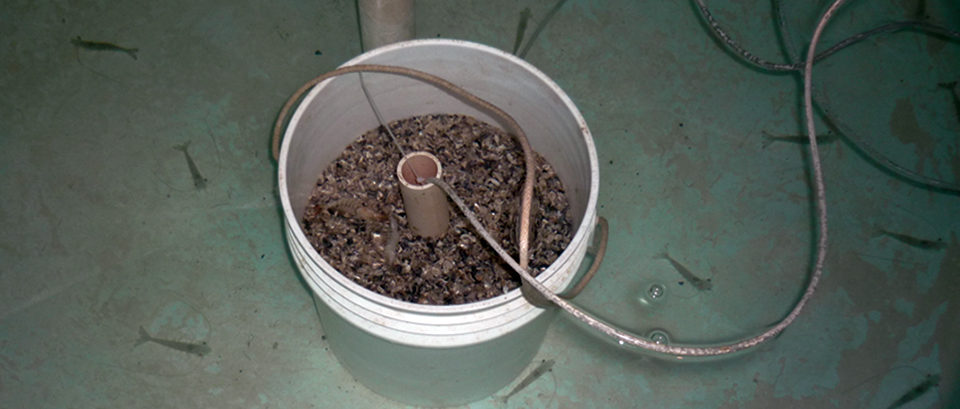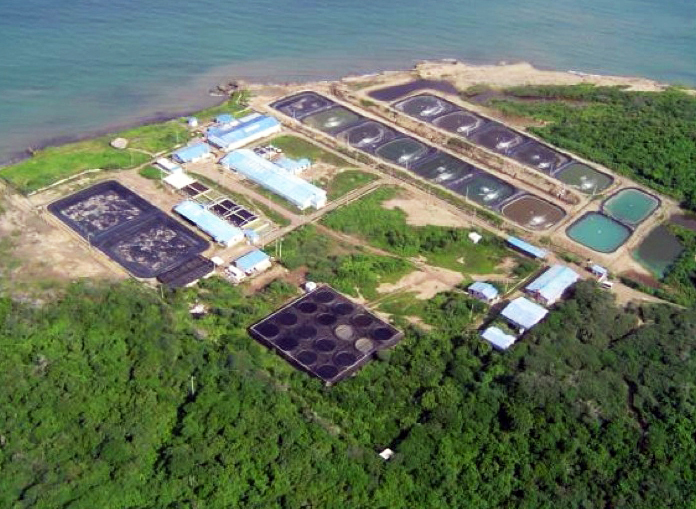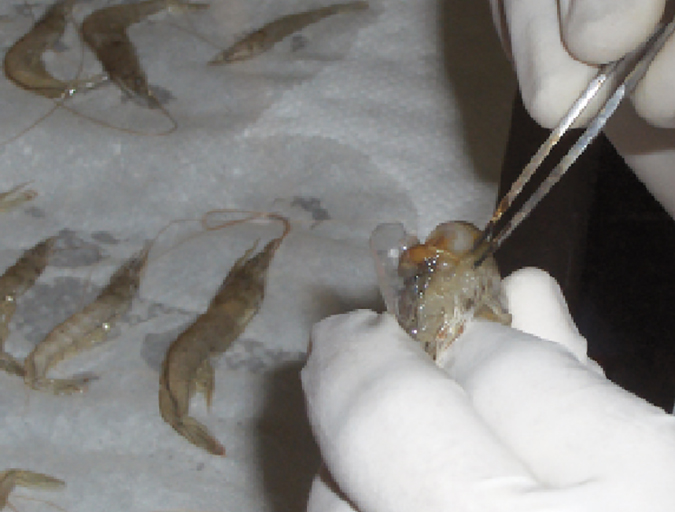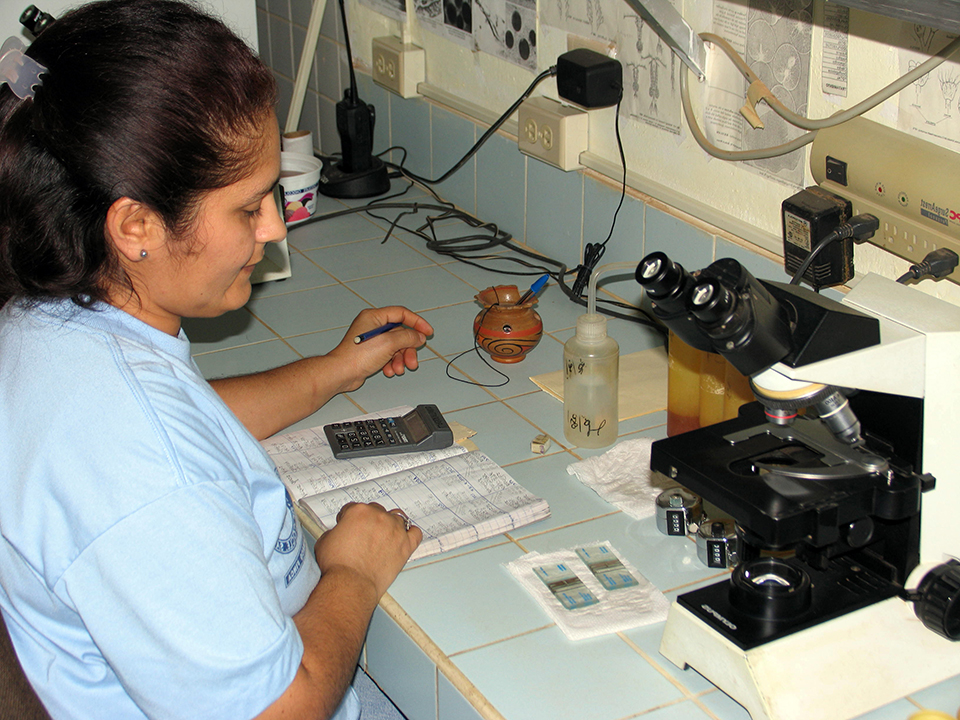First time in known scientific literature that a challenge test using a severe WSSV strain under controlled conditions identified resistance to the virus in L. vannamei

Three F8, F9 and F12 generation families of Pacific white shrimp (Litopenaeus vannamei) were challenged with white spot syndrome virus (WSSV) at the University of Arizona’s Aquaculture Pathology Laboratory. These families were developed by the Panamanian shrimp company Camaronera de Coclé, S.A. (CAMACO) from founder stocks that survived white spot a decade ago. All three lines were obtained through the selective breeding of offspring from multiple generations since 2001 that were survivors of experimental WSSV infections.
The family identified as LP-1 was F9 generation and produced by artificial insemination from one female and one male. The second family, LP-2, was obtained by crossing females from a mass-selected F11 population with F8 generation males from the LP-1 family using natural copulation. The third LP-3 family was in the F12 generation and obtained by crossing shrimp previously produced by mass selection and natural copulation from a mixture of all individually selected and WSSV-challenged families.
Study setup
L. vannamei stock with average weight of 1.5 grams per shrimp were shipped to the University of Arizona from CAMACO in Panama. On arrival, the shrimp were acclimated and stocked at 50 to 96 animals per tank into nine, 1,000-L fiberglass tanks containing artificial seawater with 30-ppt salinity and 26 degrees-C temperature. The shrimp were allowed to recover from shipping stress for three days prior to the WSSV challenge studies.
The experimental challenge consisted of three negative environmental control tanks, each containing representatives from one of the families, which were challenged separately with WSSV. Six tanks were utilized for challenging the three families with WSSV and included two replicates for each family. A positive control consisting of 20 Kona specific pathogen-free (SPF) reference line L. vannamei with average weight of 1.5 grams was challenged with WSSV in a 90-L glass aquarium.
The Kona stock were fed the same batch of WSSV tissue as the three Panamanian families to ensure that the tissue used was infectious and provide a basis with which to measure and compare survival. All tanks were equipped with air diffusers to provide sufficient aeration and an acclimated oyster shell internal recirculating biological filter. Each tank was covered with a plastic sheet to contain aerosols and minimize water temperature fluctuations.
WSSV challenge
China isolate WSSV-CN95 was chosen for this challenge study because it is the reference isolate most often used by the university laboratory and has shown consistency in virulence since it was obtained in 1995. Shrimp in the challenge tanks and positive control tank were initially given one feeding of WSSV-infected minced frozen animals at a rate of 5 percent of their average body weight. Beginning the next day, all the shrimp were fed a commercial pelleted shrimp diet.
Dead and moribund animals were recorded and removed from the tanks daily. Dead shrimp were frozen at minus-70 degrees-C. Moribund animals and some of the survivors at termination on day 17 were preserved in fixative and processed using routine histology to confirm WSSV infection status. An additional five WSSV survivors from each tank were frozen and individually tested by quantitative polymerase chain reaction (qPCR) to determine their WSSV status and viral load.
Survival
Survival at termination in the negative control families was 95, 98 and 100 percent. Survival in the Kona WSSV-positive control was 0 percent, as all the shrimp died by six days after infection. Survival in the WSSV-challenged groups was 23, 57 and 26 percent for LP-1, LP-2 and LP-3, respectively (Table 1).
Cuéllar-Anjel, Experimental design utilized in the WSSV, Table 1
| Family | Treatment | Survival |
|---|
Family | Treatment | Survival |
|---|---|---|
| LP-1 | Negative control | 49 of 50/98% |
| LP-2 | Negative control | 91 of 96/95% |
| LP-3 | Negative control | 68 of 68/100% |
| Kona | WSSV positive control | 0 of 20/0% |
| LP-1 (2 tanks) | WSSV challenge | 24 of 104/23% |
| LP-2 (2 tanks) | WSSV challenge | 74 of 129/57% |
| LP-3 (2 tank) | WSSV challenge | 34 of 130/26% |
WSSV challenges performed at the University of Arizona using L. vannamei from 1996 to 2010 resulted in an overall survival rate of about 5 percent with a low of 0 percent and a high of 25 percent. A total of 176 families were challenged during this period, most of which had no survival. Occasionally, one to five survivors were noted within a single family. The highest survival noted reflected five animals from a single family.
The results of the 2011 challenge were unusual in that survival rates were much higher, and the survivors were in the same tank with shrimp with severe WSSV infections and chronic mortalities that did not cease until about two days prior to termination of the study.
Histological observations
Histological examination of specimens collected prior to the start of this study showed no sign of infection by WSSV, Taura syndrome virus or other significant shrimp disease agents. The severity of white spot disease pathology was high in all of the moribund specimens collected after day 4 in the study. The severity of infection was due to the very high number of cells in target tissues presenting fully developed basophilic intranuclear inclusion bodies.
WSSV has an anti-apoptosis gene, which has been suggested to be the reason species like the Australian redclaw crayfish (Cherax quadricarinatus) can present severe WSSV infections while not suffering high mortalities. Perhaps the selection for WSSV resistance in the three families tested in this study was related to the up regulation of the anti-apoptosis gene of WSSV, up regulation of a shrimp apoptosis gene or some combination of these and other possible explanations consistent with high levels of WSSV replication, but reduced or delayed mortality.
However, not consistent with the hypothesis of the up regulation of the anti-apoptosis gene(s) of the virus or shrimp host was the finding that the shrimp that survived to termination on day 17 presented no histological signs of WSSV infection, nor did they contain a detectable level of WSSV by qPCR.
With a detection limit of 1 WSSV genome copy, this finding suggested that the survivors from all three families in the study either were never infected with WSSV (while others from the same family in the same tank died from WSSV) or that they were sufficiently resistant to the virus to clear it to levels below the detection limit of the qPCR test (Table 2).
Cuéllar-Anjel, Pathology and histology results, Table 2
| Day of Sample | Number Examined | Treatment | Histology Results | qPCR Results |
|---|
Day of Sample | Number Examined | Treatment | Histology Results | qPCR Results |
|---|---|---|---|---|
| 0 | 3, 3, 3 | LP-1, LP-2, LP-3 | No WSSV lesions | – |
| 4 | 1 | Kona/+WSSV control | Severe WSSV lesions | – |
| 4, 5 ,12 | 3 | LP-1/WSSV | Severe WSSV lesions | – |
| 3, 4, 5, 11 | 4 | LP-2/WSSV | Severe WSSV lesions | – |
| 4, 5, 15 | 5 | LP-3/WSSV | Severe WSSV lesions | – |
| 17 | 2, 2, 2 | LP-1, LP-2, LP-3/WSSV | No WSSV lesions | – |
| 17 | 11 | LP-1/WSSV | – | Not detected |
| 17 | 9 | LP-2/WSSV | – | Not detected |
| 17 | 10 | LP-3/WSSV | – | Not detected |
Editor’s Note: This is the first time in the known scientific literature that a challenge test using a severe WSSV strain under controlled conditions identified resistance to the virus in L. vannamei, as demonstrated by CAMACO genetics.
(Editor’s Note: This article was originally published in the July/August 2011 print edition of the Global Aquaculture Advocate.)
Authors
-
Jorge Cuéllar-Anjel
Camaronera de Coclé, S.A.
Natá (Coclé), Apartado 0823-058-19
Panamá, República de Panamá -
Roberto Chamorro
Camaronera de Coclé, S.A.
Natá (Coclé), Apartado 0823-058-19
Panamá, República de Panamá -
Brenda White-Noble
Department of Veterinary Science and Microbiology
University of Arizona
Tucson, Arizona, USA -

Paul Schofield
Department of Veterinary Science and Microbiology
University of Arizona
Tucson, Arizona, USA -

Donald V. Lightner, Ph.D.
Department of Veterinary Science and Microbiology
University of Arizona
Tucson, Arizona, USA
Tagged With
Related Posts

Health & Welfare
CENIACUA develops WSSV-resistant shrimp in Colombia
To combat white spot syndrome virus (WSSV) in white shrimp, Corporación Centro de Investigación de la Acuacultura de Colombia (CENIACUA) initiated a selective-breeding program to develop resistance in shrimp.

Health & Welfare
Double-stranded RNA against WSSV genes provides antiviral protection in shrimp
Silencing genes in white spot syndrome virus (WSSV) with critical roles in replication could provide a strong antiviral effect and thus reduce shrimp mortality. The authors therefore established a study to evaluate the antiviral efficacy of double-stranded (ds)RNA against non-structural WSSV genes.

Health & Welfare
Effective management of WSSV in shrimp
As research on WSSV continues, commonsense steps can lessen the potential impacts of white spot syndrome virus on shrimp-farming operations.

Health & Welfare
A comprehensive look at the Proficiency Test for farmed shrimp
The University of Arizona Aquaculture Pathology Laboratory has carried out the Proficiency Test (PT) since 2005, with 300-plus diagnostic laboratories participating while improving their capabilities in the diagnosis of several shrimp pathogens.


